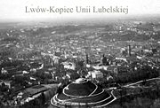
Union of Lublin Mound
Encyclopedia

Union of Lublin
The Union of Lublin replaced the personal union of the Kingdom of Poland and the Grand Duchy of Lithuania with a real union and an elective monarchy, since Sigismund II Augustus, the last of the Jagiellons, remained childless after three marriages. In addition, the autonomy of Royal Prussia was...
. It is located on the summit of Lviv High Castle
Lviv High Castle
The Lviv High Castle or Lviv Castle Hill is a historic castle located on one of the hills of the Western Ukrainian city of Lviv. It is currently the highest point in the city, 413 metres above sea level....
.
In the second half of the 19th century Poles
Poles
thumb|right|180px|The state flag of [[Poland]] as used by Polish government and diplomatic authoritiesThe Polish people, or Poles , are a nation indigenous to Poland. They are united by the Polish language, which belongs to the historical Lechitic subgroup of West Slavic languages of Central Europe...
living under Russian
Russian Empire
The Russian Empire was a state that existed from 1721 until the Russian Revolution of 1917. It was the successor to the Tsardom of Russia and the predecessor of the Soviet Union...
, Prussia
Prussia
Prussia was a German kingdom and historic state originating out of the Duchy of Prussia and the Margraviate of Brandenburg. For centuries, the House of Hohenzollern ruled Prussia, successfully expanding its size by way of an unusually well-organized and effective army. Prussia shaped the history...
n and Austrian
Austria-Hungary
Austria-Hungary , more formally known as the Kingdoms and Lands Represented in the Imperial Council and the Lands of the Holy Hungarian Crown of Saint Stephen, was a constitutional monarchic union between the crowns of the Austrian Empire and the Kingdom of Hungary in...
rule as a result of partitions of Poland
Partitions of Poland
The Partitions of Poland or Partitions of the Polish–Lithuanian Commonwealth took place in the second half of the 18th century and ended the existence of the Polish–Lithuanian Commonwealth, resulting in the elimination of sovereign Poland for 123 years...
, were looking for every opportunity to celebrate important events from the Polish history, reminding them of Poland
Poland
Poland , officially the Republic of Poland , is a country in Central Europe bordered by Germany to the west; the Czech Republic and Slovakia to the south; Ukraine, Belarus and Lithuania to the east; and the Baltic Sea and Kaliningrad Oblast, a Russian exclave, to the north...
's past glories.
At the time Austria-Hungary had the most liberal policy towards ethnic minorities. The province of Galicia, created from the areas taken over from Poland, with Polish
Polish language
Polish is a language of the Lechitic subgroup of West Slavic languages, used throughout Poland and by Polish minorities in other countries...
as one of the official languages, was the most obvious location for such celebrations. Lwów, Galicia's capital, was chosen for the occasion. The city's Polish population of all ages and classes offered voluntary labour to build the mound. The work was carried out without any prior engineering advice, using locally available materials, including stones from the ruins of High Castle. In 1906 a part of the mound collapsed and had to be rebuilt.
There is an observation platform at the top of the mound (altitude 413 m), offering a vantage viewpoint over Lwów.

